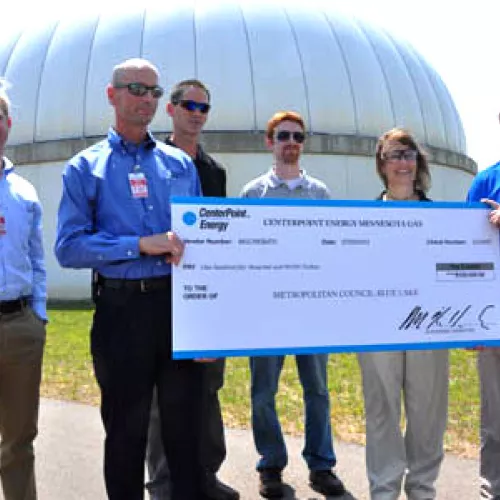Energy savings were cause for great celebration on July 11th when CenterPoint Energy awarded a sizable check to Metropolitan Council Environmental Services for huge savings at the Blue Lake Wastewater Treatment Plant in Shakopee, Minnesota.
CenterPoint Energy presented representatives of the Blue Lake plant with a rebate check for $150,000 for their efforts in energy conservation in the development, building and strategic use of a new anaerobic digestion system. “This project is the first of its kind for CenterPoint Energy’s Custom Rebate program,” said Russ Wagner, key account manager at CenterPoint Energy. “Through the efforts of the engineers and construction personnel at Blue Lake, the Metropolitan Council Environmental Services (Met Council), as well as the Minnesota Department of Commerce, this first-of-its-kind project qualified for the large rebate.”
CenterPoint Energy has long offered custom rebates to businesses across many different industries, but this project was ahead of the curve and precedent-setting, in that it was the first new-construction of anaerobic digesters that the company has rebated. “Over the many years of offering a custom rebate program, most of the easier, large energy-saving projects have been completed. With our energy saving goals continuing to increase, we needed to find large, new sources of energy savings and we thought digesters could be an excellent source of those savings,” added Wagner.
“We wanted to see if this project could fit our program’s requirements for rebate eligibility, which include cost-effectiveness and verification of the energy savings achieved, as well as program policy guidelines from the State of Minnesota,” said Nick Mark, CenterPoint Energy’s Manager for Conservation and Renewable Energy Policy.
CenterPoint Energy and the Metropolitan Council worked closely with Minnesota regulators to assess and measure the energy that was being saved over a six-month data collection and review period. As the data showed, the digester system is already saving energy comparable to the annual gas usage of about 900 residential customers each year. In fact, in the first year of operation, consumption of purchased natural gas for operating the solids pelletizer system is already seeing about an 80 percent reduction.
Energy savings come full circle
The project came to light back in 2006 with the need to increase capacity and reliability of the solids pelletizing dryer at the Blue Lake plant. Rather than build another new dryer, the project team considered alternative processes to satisfy the agency’s long term energy reduction goals and reduce the solids loading on the existing dryer.
Options evaluated were to add an additional sludge dryer, which would increase the plant’s use of natural gas, or to install anaerobic digesters. An anaerobic digester cultivates bacteria naturally occurring in the waste to break down wastewater sludge into biogas, which is then used to fuel the existing dryer and hot water boilers. “We wanted to pursue the greatest potential for energy savings, and we found that the anaerobic digester was the best choice to create “green” energy,” said Carol Mordorski, principal engineer at Metropolitan Council.
As part of the digester system construction, the existing dryer burner equipment was retrofitted so that it can burn either natural gas or the in-house produced biogas. The raw biogas produced by the digesters is conditioned to remove its high moisture content. Once conditioned, it has approximately 55 to 60 percent of the heat content of natural gas, and by using it where and whenever possible, the sludge dryer is able to reduce its energy consumption by about 80 percent.
How Blue Lake’s digester project is saving energy
- The digesters produce biogas from the wastewater sludge, which in turn is burned in the dryer to displace natural gas.
- The digester gas replaces 80 to 100% of the purchased natural gas needed to fuel the dryer.
- A heat recovery system was also installed on the dryer exhaust scrubber system. This system recovers 1.85 MMBtu /hr of waste hot water from an odor control system to maintain the digester’s operating temperature of 98 F, eliminating all heating requirements of the digesters whenever the dryer is operating.
- In the future, the biogas will be used to fuel boilers for heating the control building.
The Met Council’s projected and documented energy savings of 80,000 Dth/year is about 80 percent of the dryer’s pre-project energy consumption.
“We are learning as we go about how much biofuel we can produce and how much energy and cost savings we can realize,” added Mordorski. “Less gas is needed because there is actually less sludge to dry overall.” The digester reduces the mass of the solids loading to be dried by 30 percent, so another dryer may not be needed to meet the increased loading to the plant until about 2030.
“The Blue Lake project is being touted as an example of environmental awareness and action by the Department of Commerce’s Division of Energy Resources,” said Jessica Burdette, Division of Energy Resources. “On behalf of the Department of Commerce, we hope to see more projects like this.”
“We’re very excited about the energy-saving potential from prospective digesters that could be installed in other facilities with organic waste treatment problems, especially our food processing customers, who have historically been very active Conservation Improvement Program participants,” said Wagner. “We also think this project has the potential to be replicated at other wastewater treatment plants around our Minnesota service territory.”
Learn more
About the Local Government Energy Action Series:
This year-long effort tells the stories of nearly 50 Minnesota municipalities, counties, and schools and the tangible results of their energy-saving efforts to inspire others to take their own actions.
Local Government Energy Action is brought to you by the Clean Energy Resource Teams (CERTs) in partnership with the Minnesota Department of Commerce, Division of Energy Resource


